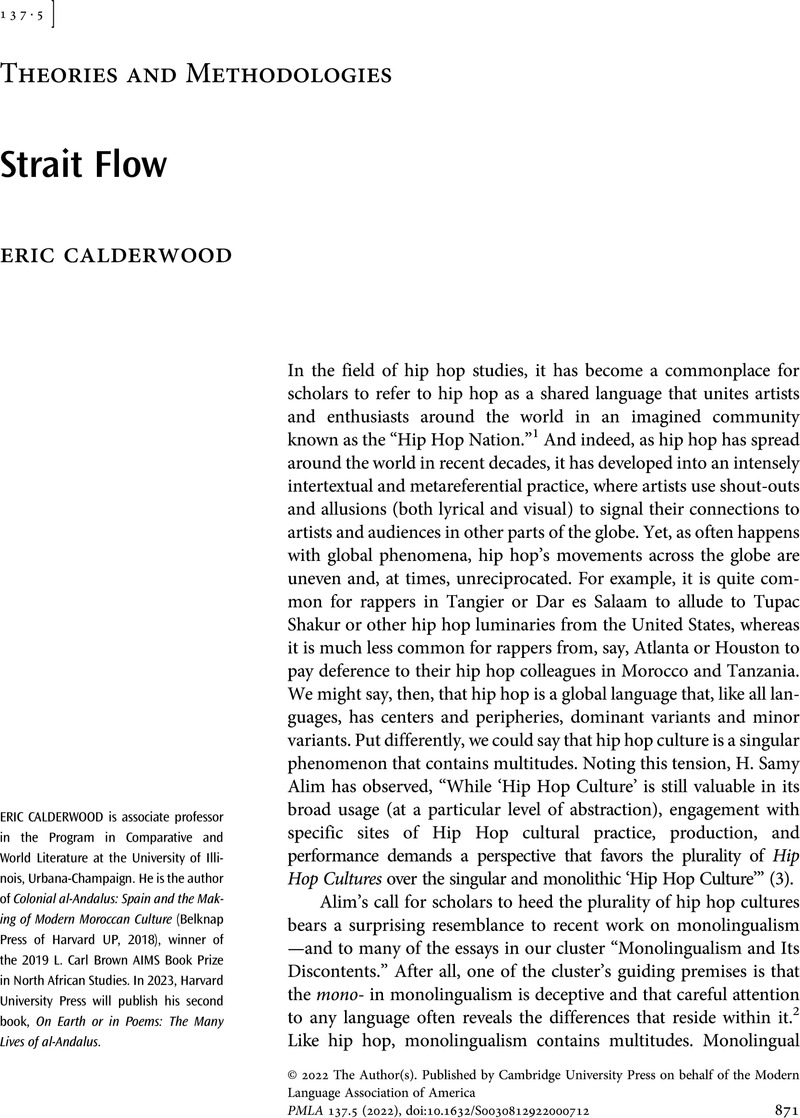No CrossRef data available.
Article contents
Abstract
An abstract is not available for this content so a preview has been provided. Please use the Get access link above for information on how to access this content.

- Type
- Theories and Methodologies
- Information
- Copyright
- Copyright © 2022 The Author(s). Published by Cambridge University Press on behalf of the Modern Language Association of America
References
Works Cited
Alim, H. Samy. “Intro: Straight Outta Compton, Straight aus München: Global Linguistic Flows, Identities, and the Politics of Language in a Global Hip Hop Nation.” Global Linguistic Flows: Hip Hop Cultures, Youth Identities, and the Politics of Language, edited by Alim, et al. , e-book ed., Routledge, 2009, pp. 1–22.Google Scholar
Alim, H. Samy, and Alastair Pennycook, . “Glocal Linguistic Flows: Hip-Hop Culture(s), Identities, and the Politics of Language Education.” Journal of Language, Identity, and Education, vol. 6, no. 2, 2007, pp. 89–100, https://doi.org/10.1080/15348450701341238.CrossRefGoogle Scholar
Calderwood, Eric. Colonial al-Andalus: Spain and the Making of Modern Moroccan Culture. Belknap Press of Harvard UP, 2018.Google Scholar
Calderwood, Eric. On Earth or in Poems: The Many Lives of al-Andalus. Harvard UP, forthcoming.Google Scholar
Calderwood, Eric. “Spanish in a Global Key.” Journal of Spanish Cultural Studies, vol. 20, nos. 1–2, 2019, pp. 53–65, https://doi.org/10.1080/14636204.2019.1609234.Google Scholar
Caubet, Dominique. “Darija and the Construction of ‘Moroccanness.’” Identity and Dialect Performance: A Study of Communities and Dialects, edited by Bassiouney, Reem, Routledge, 2018, pp. 99–124.Google Scholar
Elinson, Alexander E. “Dārija and Changing Writing Practices in Morocco.” International Journal of Middle East Studies, vol. 45, 2013, pp. 715–30, https://doi.org/10.1017/S0020743813000871.CrossRefGoogle Scholar
Guerrero, Jairo. “Zanka Flow: Rap en árabe marroquí.” Romano-Arabica, vol. 12, 2012, pp. 125–57.Google Scholar
Guissemo, Manuel Armando. “Hip Hop Activism: Dynamic Tension between the Global and Local in Mozambique.” Journal of World Popular Music, vol. 5, no. 1, 2018, pp. 50–70.CrossRefGoogle Scholar
Higgins, Christina. “From Da Bomb to Bomba: Global Hip Hop Nation Language in Tanzania.” Global Linguistic Flows: Hip Hop Cultures, Youth Identities, and the Politics of Language, edited by Alim, H. Samy et al. , e-book ed., Routledge, 2009, pp. 95–112.Google Scholar
Khaled. “Camarón.” With Cookin Soul. YouTube, uploaded by Santos, Los, 6 Jan. 2016, youtu.be/yTfdTQUsRUw.Google Scholar
Khaled “Los Foreign.” With Pxxr Gvng and Los Zafiros. YouTube, uploaded by Santos, Los, 8 Feb. 2015, youtu.be/wjNRk63XFdk.Google Scholar
Moreno-Almeida, Cristina. “Reporting on Selective Voices of ‘Resistance’: Secularism, Class and ‘Islamist’ Rap.” International Journal of Cultural Studies, vol. 21, no. 4, 2017, pp. 343–58, https://doi.org/10.1177/1367877917694093.CrossRefGoogle Scholar
Rollefson, J. Griffith. Flip the Script: European Hip Hop and the Politics of Postcoloniality. E-book ed., U of Chicago P, 2017.CrossRefGoogle Scholar
Salois, Kendra. “Fleas in the Sheepskin: Glocalization and Cosmopolitanism in Moroccan Hip-Hop.” Islam and Popular Culture, edited by Nieuwkerk, Karin van et al. , U of Texas P, 2016, pp. 364–81.CrossRefGoogle Scholar
Spady, James G., et al. Tha Global Cipha: Hip Hop Culture and Consciousness. Black History Museum Press, 2006.Google Scholar


